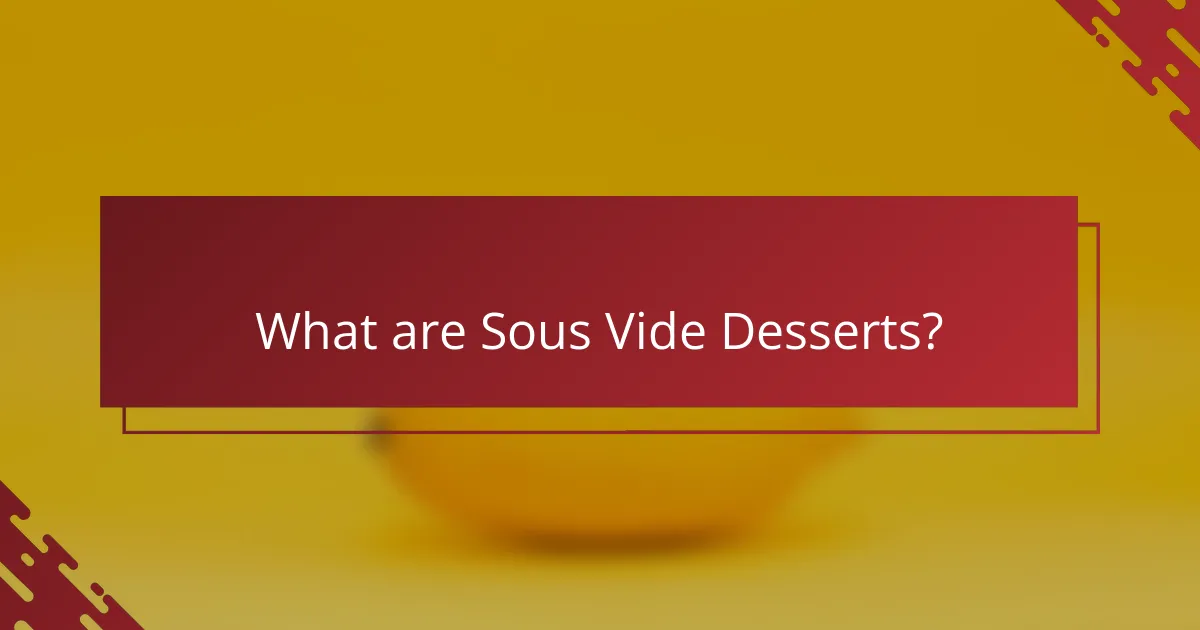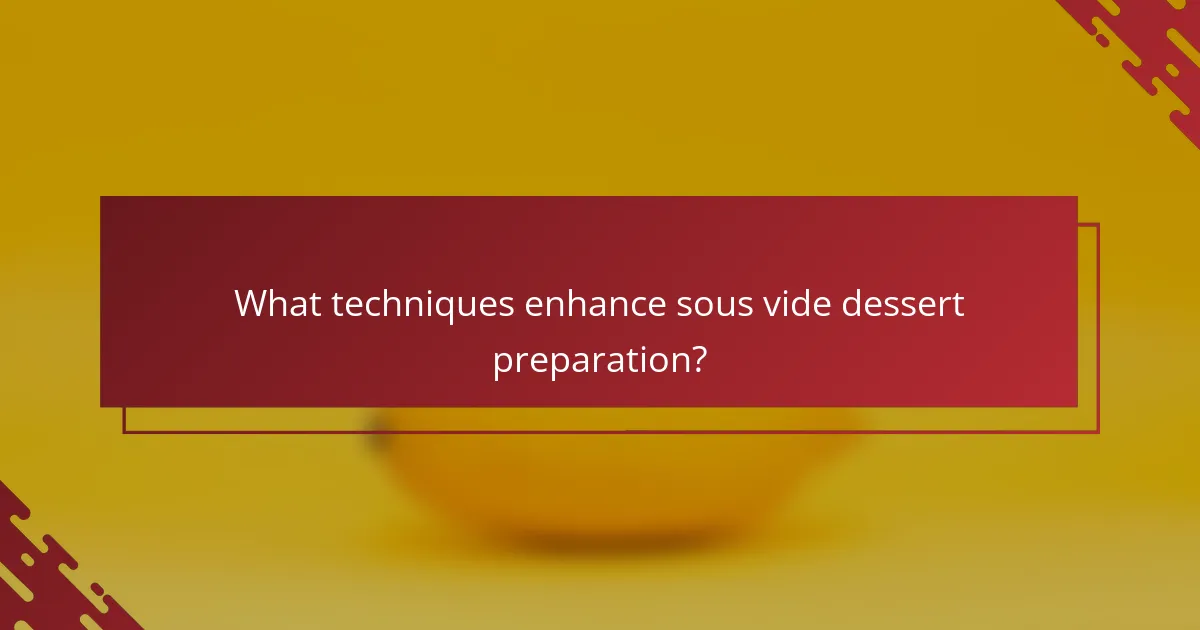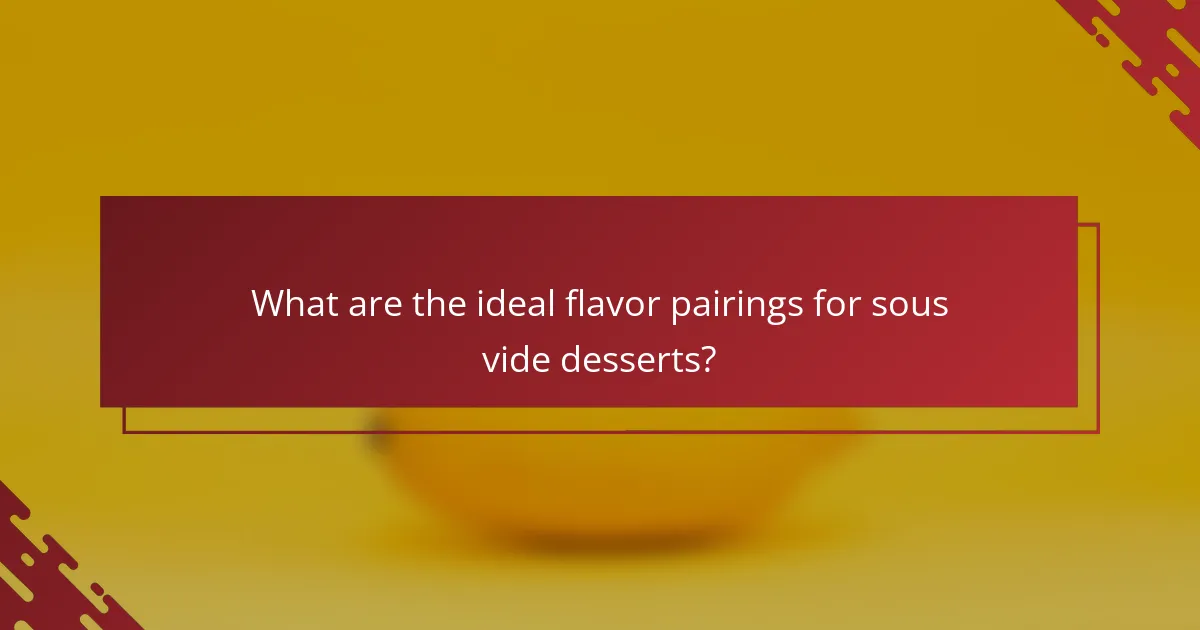Sous vide desserts are sweet dishes created using the sous vide cooking technique, which involves vacuum-sealing ingredients and cooking them in a water bath at controlled temperatures. This method ensures even heat distribution, preserving moisture and enhancing flavor. The article covers essential techniques for preparing sous vide desserts, including precise temperature control, vacuum sealing, and flavor infusion, as well as ideal flavor pairings like chocolate with sea salt and vanilla with citrus. Additionally, it explores presentation ideas that elevate the visual appeal of these desserts, emphasizing the use of elegant glassware and garnishes to enhance the overall dining experience.

What are Sous Vide Desserts?
Sous vide desserts are sweet dishes prepared using the sous vide cooking technique. This method involves vacuum-sealing food in a bag and immersing it in a water bath at a precise temperature. The controlled cooking environment allows for even heat distribution. As a result, desserts retain moisture and flavor. Common sous vide desserts include custards, panna cotta, and chocolate mousse. The technique enhances texture and allows for unique flavor infusions. It is popular among chefs for its consistency and precision.
How does the sous vide technique apply to dessert making?
The sous vide technique applies to dessert making by allowing precise temperature control during cooking. This method ensures consistent results and enhances flavors. For example, custards can be cooked evenly without the risk of curdling. Sous vide can also be used for infusing flavors into fruits or creams. The technique helps in achieving a smooth texture in desserts like panna cotta. Additionally, sous vide cooking can intensify the taste of chocolate or caramel. Many chefs utilize sous vide for creating delicate desserts that require careful temperature management. Studies show that sous vide desserts often outperform traditional methods in texture and flavor retention.
What equipment is necessary for sous vide desserts?
The necessary equipment for sous vide desserts includes a sous vide immersion circulator, vacuum sealer, and heat-safe bags. A sous vide immersion circulator maintains precise water temperatures for cooking. The vacuum sealer removes air from bags to ensure even cooking and prevent water from entering. Heat-safe bags are essential for containing the dessert mixture during the sous vide process. Using these tools allows for consistent texture and flavor in desserts.
What are the key principles behind sous vide cooking?
Sous vide cooking involves immersing food in a water bath at controlled temperatures. This method ensures precise cooking by maintaining a consistent heat. The key principles include temperature control, vacuum sealing, and long cooking times. Temperature control allows for even cooking without overcooking. Vacuum sealing prevents moisture loss and enhances flavor infusion. Long cooking times enable the breakdown of tough fibers in meats and the development of flavors in desserts. Studies show that sous vide can preserve nutrients better than traditional cooking methods. This technique is widely used in professional kitchens for its reliability and versatility.
What types of desserts can be made using sous vide?
Sous vide can be used to make a variety of desserts. Common options include custards, puddings, and cheesecakes. Chocolate mousse benefits from the precise temperature control of sous vide. Fruit compotes can be infused with flavors effectively using this technique. Crème brûlée is another popular dessert that achieves a smooth texture through sous vide cooking. Additionally, sous vide can be used for poached fruits, providing consistent results. These desserts showcase the versatility of sous vide in achieving unique textures and flavors.
Which ingredients work best for sous vide desserts?
Eggs are the primary ingredient that works best for sous vide desserts. They provide structure and richness to custards and puddings. Common applications include crème brûlée and flan. Sugar enhances flavor and aids in caramelization during the sous vide process. Dairy products, like cream and milk, contribute to a smooth texture. Chocolate is another excellent choice; it melts evenly and combines well with other flavors. Fruits can be infused or pureed for added sweetness and acidity. Flavorings such as vanilla, spices, and extracts elevate the overall taste profile. These ingredients are ideal because they respond well to the precise temperature control of sous vide cooking.
How do different dessert forms (custards, cakes, etc.) adapt to sous vide?
Different dessert forms adapt to sous vide by utilizing precise temperature control and even cooking. Custards benefit from sous vide by achieving a creamy texture without curdling. The gentle heat allows for uniform cooking, which enhances flavor integration. Cakes can also adapt, resulting in moist and tender crumb structures. The sous vide method prevents overcooking, maintaining the cake’s structural integrity. Additionally, sous vide allows for infusing flavors directly into the desserts. This technique can enhance the overall taste profile, making desserts more flavorful. Many chefs report that sous vide desserts often have a more intense flavor compared to traditional methods.

What techniques enhance sous vide dessert preparation?
Techniques that enhance sous vide dessert preparation include precise temperature control, vacuum sealing, and flavor infusion. Precise temperature control allows desserts to cook evenly and maintain desired textures. Vacuum sealing prevents water from entering the bags, ensuring that ingredients retain their flavors. Flavor infusion can be achieved by adding herbs, spices, or citrus zest to the vacuum bags. This method enhances the overall taste profile of the dessert. Additionally, using water baths with circulators ensures consistent heat distribution. Experimenting with cooking times can also yield different textures and flavors. These techniques collectively improve the quality and creativity of sous vide desserts.
How can flavor infusion be achieved in sous vide desserts?
Flavor infusion in sous vide desserts can be achieved by immersing ingredients in a vacuum-sealed bag with flavoring agents. Common flavoring agents include herbs, spices, citrus peels, and extracts. The sous vide cooking process allows for precise temperature control, which helps to extract and meld flavors effectively.
Cooking at lower temperatures for longer periods enhances the infusion process. For example, infusing vanilla in custards can take several hours at 85°C (185°F). The vacuum seal prevents oxidation and preserves the integrity of the flavors.
Research shows that sous vide methods can enhance flavor extraction compared to traditional cooking techniques. A study by the Culinary Institute of America highlights that sous vide can intensify the flavor profile of infused ingredients.
What methods are effective for infusing flavors?
Effective methods for infusing flavors include sous vide cooking, steeping, and maceration. Sous vide cooking allows precise temperature control, enhancing flavor extraction. Steeping involves soaking ingredients in a liquid, releasing essential oils and compounds. Maceration breaks down food, promoting flavor release through sugar or salt addition. Each method can be adjusted for time and temperature to achieve desired flavor intensity. For example, sous vide can infuse flavors at lower temperatures over extended periods, such as 60°C for several hours. These techniques are widely used in culinary practices to create rich, complex flavors in desserts.
How does vacuum sealing impact flavor extraction?
Vacuum sealing enhances flavor extraction by removing air and creating a controlled environment. This process allows flavors to concentrate and meld more effectively. In vacuum-sealed bags, food items are in close contact, promoting the transfer of volatile compounds. Studies show that sous vide cooking with vacuum sealing can intensify flavors by up to 30%. Additionally, the absence of oxygen minimizes oxidation, preserving fresh flavors. This method also allows for even heat distribution, further enhancing the overall taste profile.
What are the best practices for sous vide cooking times and temperatures?
The best practices for sous vide cooking times and temperatures involve precise temperature control and timing for optimal results. For example, cooking eggs sous vide at 63°C (145°F) for 45 minutes yields a perfect custard-like texture. Cooking chicken at 65°C (149°F) for 1.5 to 4 hours ensures it remains juicy and tender. For vegetables, a temperature of 85°C (185°F) for 30 to 60 minutes enhances flavor while maintaining texture. Cooking steak at 55°C (131°F) for 1 to 4 hours results in medium-rare doneness. Accurate sous vide cooking relies on maintaining consistent temperatures and times for desired outcomes.
How do cooking times vary by dessert type?
Cooking times vary significantly by dessert type. For example, custards typically require 60 to 90 minutes at 176°F (80°C). Cakes often need 1 to 2 hours at 185°F (85°C). Puddings can cook in about 1 hour at 176°F (80°C). Fruit desserts usually take 30 to 60 minutes at 185°F (85°C). These variations depend on the ingredients and desired texture. The sous vide method allows precise temperature control, ensuring consistent results for each dessert type.
What temperature ranges are optimal for different textures?
Optimal temperature ranges for different textures in sous vide desserts vary significantly. For custards, a temperature of 80-85°C (176-185°F) yields a creamy texture. Chocolate textures benefit from 45-50°C (113-122°F) for a smooth melt. Fruit compotes achieve optimal softness at 85-90°C (185-194°F). For gels, a range of 70-80°C (158-176°F) is ideal, ensuring proper setting. Each temperature range enhances specific dessert textures, making sous vide a precise technique.

What are the ideal flavor pairings for sous vide desserts?
Ideal flavor pairings for sous vide desserts include chocolate with sea salt, vanilla with citrus, and caramel with coffee. Chocolate and sea salt create a balanced taste, enhancing sweetness. Vanilla pairs well with citrus fruits like lemon or orange, adding brightness. Caramel combined with coffee provides a rich, deep flavor profile. Other successful pairings are berry with mint, and coconut with lime, both offering refreshing contrasts. These combinations leverage the precision of sous vide cooking to extract and intensify flavors.
How can complementary flavors enhance dessert profiles?
Complementary flavors can enhance dessert profiles by creating a balanced taste experience. These flavors work together to elevate the overall sensory appeal. For instance, the sweetness of chocolate pairs well with the acidity of citrus. This combination can brighten the dessert and add depth. Furthermore, contrasting flavors can stimulate the palate, making each bite more enjoyable. Research shows that flavor pairings can influence consumer preferences and satisfaction. A study published in the Journal of Culinary Science & Technology highlights how complementary flavors can improve the perceived quality of desserts. By carefully selecting these flavors, chefs can craft desserts that are not only delicious but also memorable.
What are some classic flavor combinations in desserts?
Classic flavor combinations in desserts include chocolate and raspberry, vanilla and almond, and lemon and blueberry. Chocolate pairs well with raspberry due to the tartness balancing the sweetness. Vanilla and almond create a warm, nutty flavor profile that enhances baked goods. Lemon and blueberry provide a refreshing contrast, with the acidity of lemon complementing the sweetness of blueberries. Other notable combinations are caramel and sea salt, which highlight the richness of caramel with a savory touch. Additionally, strawberry and basil offer a unique blend of sweet and herbal notes. These combinations are widely used in various desserts, showcasing their timeless appeal.
How can seasonal ingredients be effectively paired?
Seasonal ingredients can be effectively paired by considering their flavor profiles and seasonal availability. For example, pairing summer berries with creamy desserts enhances their natural sweetness. Autumn ingredients like pumpkin can be matched with warm spices such as cinnamon for depth. Each season offers unique flavors that complement one another. Using fresh herbs, like basil in summer, can elevate fruit-based dishes. Seasonal pairings often lead to vibrant color contrasts, enhancing visual appeal. The combination of flavors should balance sweetness, acidity, and texture for optimal results. Experimentation with contrasting and complementary ingredients can yield innovative dessert creations.
What innovative flavor pairings can be explored?
Innovative flavor pairings for sous vide desserts include lavender and honey, which create a floral sweetness. Another pairing is basil and strawberry, offering a fresh and aromatic contrast. Chocolate and chili provide a rich and spicy experience. Citrus and cardamom combine bright acidity with warm spice for depth. Matcha and coconut deliver earthy and tropical notes. Salted caramel and espresso blend sweet and bitter flavors effectively. These combinations enhance the overall dessert experience by balancing and contrasting flavors.
How do herbs and spices elevate dessert flavors?
Herbs and spices enhance dessert flavors by adding complexity and depth. They introduce unique taste profiles that can balance sweetness. For instance, basil can provide a refreshing contrast to fruity desserts. Cinnamon adds warmth, making desserts feel more comforting. The right herb or spice can elevate a simple dish into an extraordinary experience. Research indicates that flavor compounds in herbs and spices can stimulate the palate. This stimulation can lead to a more memorable tasting experience. Therefore, incorporating herbs and spices is a technique that can significantly improve dessert quality.
What unconventional ingredients can be used in sous vide desserts?
Unconventional ingredients for sous vide desserts include avocado, olive oil, and miso. Avocado can create creamy textures in puddings and mousses. Olive oil adds richness and depth to cakes and custards. Miso introduces umami flavors, enhancing sweet profiles in chocolate desserts. Other unique options are herbs like basil or rosemary, which can infuse unexpected freshness. Using these ingredients can elevate traditional dessert recipes, providing innovative flavor combinations.

How can sous vide desserts be presented attractively?
Sous vide desserts can be presented attractively by using elegant glassware. Clear containers showcase the layers and textures of the dessert. Garnishing with fresh herbs or edible flowers adds a pop of color. Drizzling sauces or coulis around the plate enhances visual appeal. Using contrasting colors in components creates a striking presentation. Plating with precision and care reflects professionalism. Incorporating textures, such as crunchy toppings, adds interest. These methods enhance the overall dining experience.
What plating techniques work best for sous vide desserts?
Plating techniques that work best for sous vide desserts include layering, stacking, and using negative space. Layering involves placing different components in distinct layers to create visual depth. Stacking allows for height and dimension, making the dessert more visually appealing. Using negative space helps to draw attention to the dessert by providing contrast on the plate. Additionally, garnishing with fresh herbs or edible flowers enhances the presentation. Drizzling sauces or coulis adds color and flavor while also creating artistic patterns. These techniques elevate the overall dining experience by making the dessert visually stunning and inviting.
How can garnishes enhance visual appeal?
Garnishes enhance visual appeal by adding color, texture, and creativity to dishes. They create contrast, making the main elements stand out. For instance, a vibrant fruit garnish can brighten a neutral-colored dessert. Textured garnishes like crumbles or nuts add visual interest and depth. Creative arrangements can evoke emotions and stimulate appetite. Studies show that visually appealing food increases perceived taste quality. In culinary presentations, garnishes are essential for attracting attention and enhancing overall dining experiences.
What serving vessels are ideal for sous vide desserts?
Glass jars are ideal serving vessels for sous vide desserts. They are heat-resistant and allow for even cooking. Mason jars are commonly used due to their airtight seals. They also provide an attractive presentation for desserts. Silicone molds are another option, offering flexibility for easy removal. Stainless steel containers can also be utilized for their durability. Each vessel type ensures that desserts maintain their desired texture and flavor.
What tips can improve the overall presentation of sous vide desserts?
To improve the overall presentation of sous vide desserts, focus on plating techniques and garnishes. Use contrasting colors to create visual interest. For example, pair a creamy dessert with vibrant fruit compote. Texture variation enhances appeal; add a crunchy element like crushed nuts or cookies. Utilize elegant serving dishes that complement the dessert’s style. Incorporate sauces or coulis artistically on the plate for a professional look. Fresh herbs can add a touch of sophistication and aroma. Lastly, ensure proper portion sizes to maintain balance on the plate. These tips enhance the visual allure and overall dining experience.
How can color contrast be utilized in dessert presentation?
Color contrast can enhance dessert presentation by making the dish visually appealing. Utilizing complementary colors can create striking visuals. For example, pairing dark chocolate with bright fruits like raspberries or mangoes enhances both colors. This method draws attention and stimulates appetite. Additionally, using contrasting colors can highlight specific elements, such as a creamy panna cotta against a vibrant berry coulis. Research shows that color contrast influences perception of flavor and freshness. A study published in “Food Quality and Preference” found that visually appealing presentations can enhance the overall dining experience.
What are common mistakes to avoid when plating desserts?
Common mistakes to avoid when plating desserts include overcrowding the plate. This can make the presentation look chaotic and unappealing. Another mistake is neglecting color contrast. A lack of vibrant colors can result in a dull appearance. Failing to consider the height of the dessert can also detract from its visual appeal. Flat presentations often lack interest and depth. Additionally, ignoring the use of garnishes can leave the dessert looking unfinished. Properly chosen garnishes can enhance both flavor and presentation. Lastly, not using the right plate size can affect the overall impact. A plate that is too large can make the dessert appear small, while a plate that is too small can lead to overflow.
What troubleshooting tips are essential for sous vide desserts?
Ensure proper sealing of bags to avoid water entering. Check for leaks by submerging the bag before cooking. Use a reliable immersion circulator to maintain consistent temperature. Monitor the water bath temperature with a thermometer for accuracy. Adjust cooking times based on the dessert type and thickness. For custards, ensure they are fully set before removing from the water bath. Use a fine mesh strainer to remove any curdled bits in mixtures. Experiment with different cooking times to achieve desired textures.
How can texture issues be resolved in sous vide desserts?
Texture issues in sous vide desserts can be resolved by adjusting cooking times and temperatures. Overcooking can lead to undesirable textures, so precise temperature control is crucial. For example, using a temperature of 85°C for custards ensures a creamy consistency without curdling. Additionally, incorporating stabilizers like gelatin or agar can enhance texture. These ingredients help maintain structure and prevent separation. Lastly, blending or whipping the mixture before cooking can aerate and improve mouthfeel. This method is commonly used in recipes for mousses and soufflés.
What should be done if flavors are not balanced?
Adjust the ingredients to achieve balance. Taste the dish and identify overpowering flavors. If sweetness is lacking, add sugar or sweeteners. For acidity, incorporate lemon juice or vinegar. If bitterness is too strong, a pinch of salt can help. Adding complementary flavors can also enhance balance. Herbs or spices may provide additional depth. Always adjust in small increments to avoid overcorrection.
Sous vide desserts are sweet dishes created using the sous vide cooking technique, which involves vacuum-sealing ingredients and cooking them in a water bath at precise temperatures. This method enhances texture, flavor infusion, and moisture retention, making it ideal for various desserts such as custards, panna cotta, and chocolate mousse. Key principles include temperature control, vacuum sealing, and long cooking times, while innovative flavor pairings and effective presentation techniques are essential for elevating the dessert experience. The article covers necessary equipment, ingredient selection, cooking times and temperatures, troubleshooting tips, and best practices for achieving optimal results in sous vide dessert preparation.